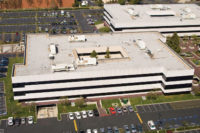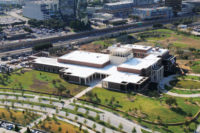The Drawing Board: Sustainable Roof and Institutional Buildings

An aerial view of the de Young Museum with a copper cladding for the roof and walls. Photos courtesy of Simpson Gumpertz & Heger Inc.

The vegetative roof on the California Academy of Sciences is one of the largest in the world.

The roof at the Contemporary Jewish Museum is made up of a combination of low-slope roofs and cubic structures.



Sustainable roofing systems can be many things, but primarily they are assemblies that provide a covering protecting a building from the elements (i.e., water, sun, cold, and heat) while minimizing their burden on the environment and conserving energy. Considerations such as low environmental impact, initial cost, life-cycle cost, as well as recycled content are all very important when assessing roof sustainability. There is presently not an accepted, all inclusive definition for a sustainable roof. This article provides the basic tenants of roof sustainability and cites recent examples where sustainable roofs were used on institutional buildings.
Sustainability
A sustainable roof needs to consider functionality service life and durability, environmental life-cycle impacts and in-service sustainability benefits. By optimizing these three items, the most sustainable roof system can be selected. For specialized institutional buildings, the roof system must meet the architectural intent as well as having the greatest durability and longest service life to offset its higher initial installation cost.
Functionality
Functionality should be paramount for any roofing design decision for a typical building where the roof surface is not being considered as aesthetic façade element. The longevity of any roof membrane or assembly must be assessed on its in-place performance in similar applications. It is a very poor decision to select a roof membrane or assembly based on manufacturers’ assurances or warranties. Only in-place performance should be the basis of establishing the roof system’s actual longevity. While there is an accepted ASTM Standard for life-cycle assessment of building materials/products (ASTM E1991 - Standard Guide for Environmental Life Cycle Assessment (LCA) of Building Material/Products), it is a work in progress only providing the tools for identifying, assessing, and interpreting the environmental impacts. It also does not look at roofs for their unique character of primarily needing to be functional with little regard for appearance.
There are numerous roofing membranes available but the designer has to carefully assess their attributes before selecting the appropriate assembly. Single-ply membranes are quite flexible and allow for flashing numerous, closely grouped penetrations but do not have the durability of multi-ply redundant systems, such as built-up roofing or modified bituminous roof assemblies. Furthermore, single-ply roof systems are highly dependent on workmanship as one error or misapplication can lead to a water entry path. Therefore, functionality should be equated to a long service life, which includes ease of initial installation to provide a watertight assembly. A functional roof is often achieved through use of a combination of time-tested roof materials (preferably multi-ply or redundant roof assemblies to allow for slight installation anomalies) that also have a high level of durability.
Durability can be considered by both in-place performance and through laboratory testing. This criterion is more difficult to assess however as the use of roof and especially the amount of roof foot traffic are important considerations. Roofs with mechanical equipment, window washing staging, or roofs that receive other forms of above average use need to be designed for above average intrinsic durability. Alternatively, roofs that have limited roof-top equipment that requires maintenance or rooftop foot traffic can arguably have a less durable roof assembly.
Low-Energy Impact
Low-energy impact can be considered two different ways: The energy usage required to extract, manufacturer, and deliver the roofing system to the specific location, and the performance of the designed roofing assembly to maximize the building’s thermal performance.
Current codes are raising the requirements for building thermal performance, but the increased thickness of conventional insulation within the roof assembly increases the membrane temperature. This can actually lead to an increase in membrane deterioration through a higher heat of reaction leading (Arnhenius equation). Therefore, the use of rigid insulation directly below the roof membrane to improve the building thermal performance may not equate to the most sustainable roof assembly.
There are alternate insulation assemblies that reduce the heat to the roof membrane by creating a higher heat capacity directly under the roof. Unlike rigid insulation, which has a low heat capacity, lightweight insulating concrete with embedded expanded polystyrene insulation combines the benefits of high heat capacity and thermal insulation. Therefore, it produces low membrane temperature but high thermal efficiency to improve the building-energy usage. Other added benefits with lightweight insulating concrete are the high compressive strengths (which provides a more stable and durable substrate to accept foot- and window-washing traffic), fire and wind resistance, and the possibility of keeping the material in-place when the roof is eventually replaced. All of these attributes help the overall sustainability of the roof system.
San Francisco Institutional Buildings
Recently three buildings in San Francisco were completed with roof systems that met the requirements of sustainability and also provided aesthetic roof coverings that were important parts of the building architecture. These roof systems are, and expected to be, high-performing roof systems that will last for an extended period of time (e.g., more than 20 years). Their extended performance contributes to long-term sustainability that offsets the environmental impacts of toxic emissions and the actual energy expended in the extraction, manufacturing, and installation process of these roofs. There is an added benefit with roofs which utilize fully recyclable components (i.e., copper or stainless steel panels) as the base roof covering. Since these metals are highly resistant to corrosion, they should last for decades and most probably the life of the building.
de Young Museum
The de Young Museum is the largest copper clad structure in the world. The inverted standing-seam metal roof with a linear rib layout provides an aesthetic covering that can be viewed from the tower observation floor. Due to the high initial cost, the design team understood that this roof system needed to last many years if not for the life of the building. The sustainability attributes of the copper panels are their high durability, virtually maintenance free service and corrosion resistance.
The roof design incorporates a 16-gauge primary stainless steel gutter under the 3-foot-high ribs (spaced at 12 feet on center) set over 2 inches of insulation. There is a stainless steel combination retention clip and sub-gutter assembly (commonly referred to during construction as the “cowboy hat” due to its configuration), which extends perpendicularly between the gutters. The cowboy hats were attached into the sides of the 16-gauge stainless steel gutter to provide a fixed attachment for the copper roof panels. Under the cowboy hat, is a 45-mil thermoplastic membrane. This primarily served as a temporary roof system during construction, but also provides a backup to the primary copper panel covering. Five inches of extruded polystyrene was installed below the membrane and 2 inches of cellular glass insulation was placed over the membrane (and under the copper panels). The insulation value of R-35 provided a high degree insulation to limit the museum heating and cooling costs and increased overall sustainability of the roof assembly. In addition, by placing the membrane between the layers of insulation the exterior temperature changes are modulated and the membrane is protected from ultraviolet light and weathering effects leading to a longer lasting membrane due to its lower in-place temperatures.
Lastly, prior to the installation of the 16-ounce copper panels, a layer of drainage mat was placed to allow for a minimum amount of air flow to eliminate some of the heat buildup. The drainage mat has a geotextile fabric as a cushioning layer. The roof design took into account the aesthetic requirements of the designer but also understood the need, due to the high initial cost, to provide a highly durable long-lasting roof membrane that would not require replacement; ultimately many aspects of sustainability were subsequently met.
California Academy of Sciences
The roof on the California Academy of Sciences is a design that attempts to replicate the five hills of San Francisco with a vegetative covering.
The goal with any vegetative roof is to incorporate insulation and a waterproof membrane under soil to support a living roof. Vegetative roof installations will protect the finished roof membrane and provide a long-lasting durable system as the roof is not directly exposed to inclement weather or temperature extremes. Some of the other benefits of vegetative roofs include the reduction of the urban heat island effect, which decreases the presence of smog and a decrease in storm water pollutants and runoff through filtration and retention, respectively. There is also energy efficiency from the insulative effect of the soil in conjunction with advection and transpiration effects. All of these benefits make vegetative roofs one of the more effective ways of providing sustainable roof systems as they address both life-cycle and durability concerns, but also provide many in-service benefits.
The roof system consists of a metal deck with concrete fill. The roof membrane is a hot rubberized asphaltic assembly consisting of 215 mils of rubberized asphalt, uncured neoprene flashing, a protection layer and root barrier. The 4 inches of insulation over the finished roof membrane was strapped in place as a temporary measure until the vegetative roof membrane was installed. The vegetation was installed over a 2-inch soil layer. There also is a gabion grid (i.e., rocks set in a steel cage) to control erosion and collect irrigation water on the sloped portions of the roof mounds. The design had an R-value greater R-20 (plus the benefit of the soil). The insulation had two benefits: The obvious primary benefit of requiring less heating and cooling cost for the interior space operations, but also the waterproof membrane is protected from temperature extremes and weathering effects, increasing its longevity. The rubberized asphalt membrane has been used in similar application for more than 30 years and is expected to last at least 50 years. This expectation of performance, which is more than twice as long as conventional roofing systems, helps this roof assembly meet the most important tenet of sustainability.
Contemporary Jewish Museum
The Contemporary Jewish Museum has several roofs. Over a portion of the museum are low-sloped modified bituminous roofs, but there are also several cubic structures that make up a portion of the building. These cubic structures incorporate skylights and are clad with the same inverted standing seam metal roof that was used on the de Young.
The same design concepts that were used for the de Young Museum were used for this building. The slope of the surface was, at many locations, greater than 60 degrees where the panels were used. Therefore, these locations would not be considered a roof, but instead a sloped-wall installation. For this reason, 4 inches of polyisocyanurate were used in lieu of the cellular glass insulation that was used in the de Young Museum roof assembly. Also, blue-colored stainless steel was used in lieu of copper on this roof. These panels are also highly corrosion resistant, durable and recyclable providing similar sustainability benefits.
Conclusions
The concept of sustainability for roofs needs better definition and a more quantitative approach to define each assembly. The institutional roofs discussed above were designed and constructed with sustainability in mind. The design team and owner realized the need for a sustainable roof system due to the high initial cost of the installation to reflect the specific architecture intent. The basic tenets of sustainability were incorporated into each roof by providing roof system designs that are intended to be functional with a long service life, to be highly durable, and to provide low-energy impact (i.e., low environmental life-cycle impacts and a high degree in-service sustainability benefits) to address some environmental concerns. They all incorporate a high degree of insulation to achieve interior user comfort and to limit operating cost by reducing the building’s energy demand.
These are special-use institutional buildings and their designs are not common. The cost and overall coordination to construct these types of buildings reflect the need for a sustainable roof. In each case, the ultimate design decision reflected the importance of the sustainability of the roof as opposed to concentrating solely on an aesthetic decision. Putting less emphasis on lowest initial cost and more emphasis on sustainability is a lesson that we should incorporate into the roof designs for all buildings as ultimately there will be less environmental impact.
Looking for a reprint of this article?
From high-res PDFs to custom plaques, order your copy today!









